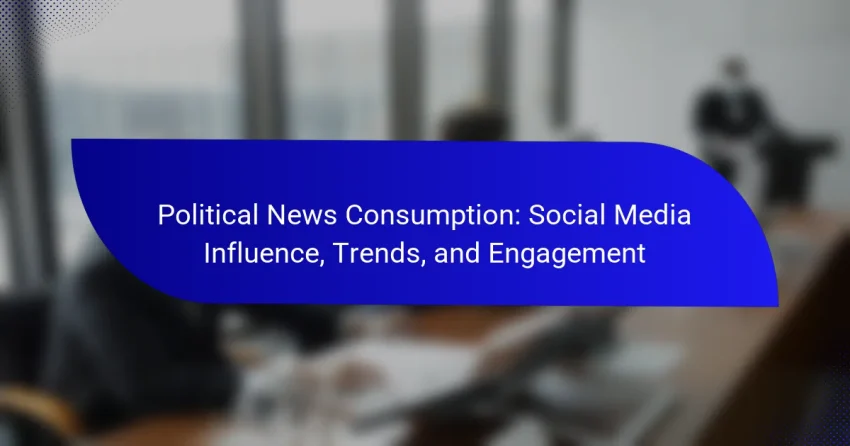The rise of social media has fundamentally altered the landscape of political news consumption, granting users instant access to a wide array of information and fostering greater engagement in public discourse. As digital platforms become the primary source for news, trends reveal a preference for visually-driven and interactive content, particularly among younger demographics. Understanding these shifts is crucial for analyzing the evolving dynamics of political engagement and information dissemination.
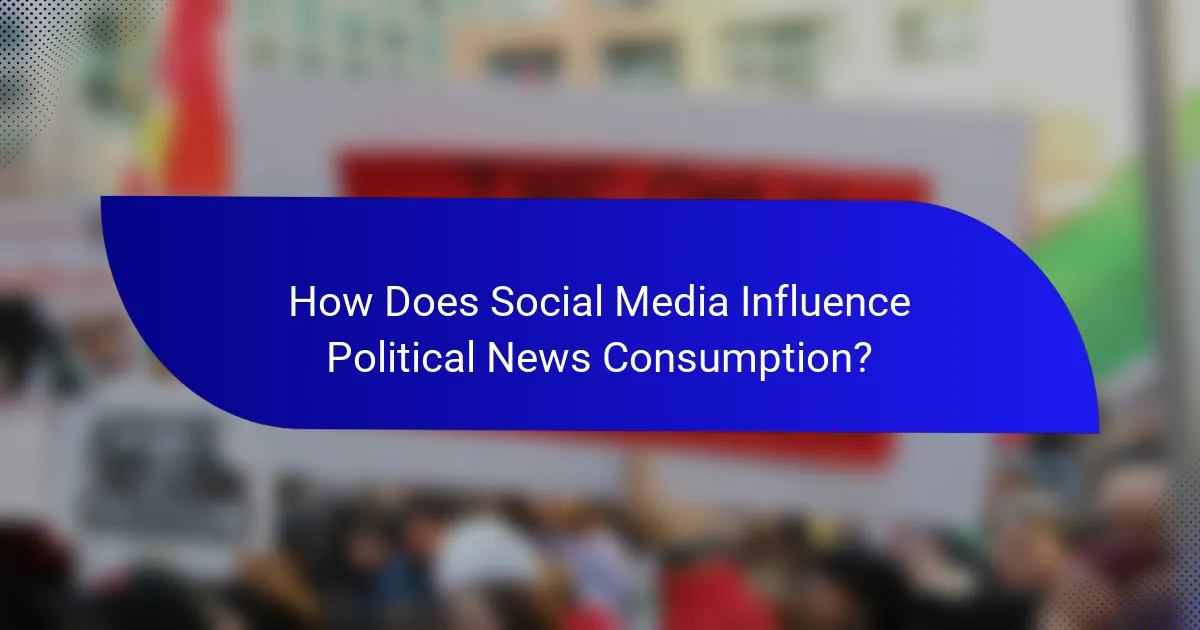
How Does Social Media Influence Political News Consumption?
Social media significantly impacts how individuals consume political news by providing immediate access to diverse information sources and facilitating engagement. This shift has transformed traditional news consumption patterns, making it essential to understand its implications on public discourse.
Increased accessibility of information
Social media platforms have democratized access to political news, allowing users to easily find and share information. This accessibility means that individuals can receive updates from various sources, including mainstream media, independent journalists, and citizen reporters.
As a result, people can engage with a broader range of perspectives, which can enhance their understanding of political issues. However, the sheer volume of information can also lead to confusion and misinformation if users do not critically evaluate the sources they encounter.
Real-time updates and engagement
Social media enables real-time updates on political events, allowing users to stay informed as news unfolds. This immediacy encourages higher engagement levels, as individuals can comment, share, and discuss news stories instantly.
For example, live-tweeting during political debates or elections allows users to interact with the content and each other, fostering a sense of community. However, this rapid flow of information can sometimes prioritize sensationalism over accuracy.
Echo chambers and polarization
Social media can create echo chambers where users are exposed primarily to viewpoints that align with their own, reinforcing existing beliefs. This phenomenon can lead to increased polarization, as individuals become less open to opposing perspectives.
To mitigate this effect, users should actively seek out diverse viewpoints and engage with content that challenges their beliefs. This practice can help foster a more balanced understanding of political issues and reduce divisive rhetoric.
Influencer impact on narratives
Influencers on social media play a crucial role in shaping political narratives by leveraging their platforms to promote specific messages. These influencers can mobilize their followers and drive discussions around particular issues, often impacting public opinion significantly.
For instance, a popular figure endorsing a political candidate can sway their audience’s perceptions and voting behavior. Users should be aware of the motivations behind influencers’ endorsements and critically assess the information they share.
Algorithm-driven content visibility
Social media algorithms determine what content users see, often prioritizing posts that generate high engagement. This can lead to a skewed representation of political news, as sensational or polarizing content may receive more visibility than balanced reporting.
Users should be mindful of how algorithms shape their news feeds and consider diversifying their sources to ensure they receive a well-rounded view of political events. Adjusting settings to follow a variety of news outlets can help counteract algorithmic biases.
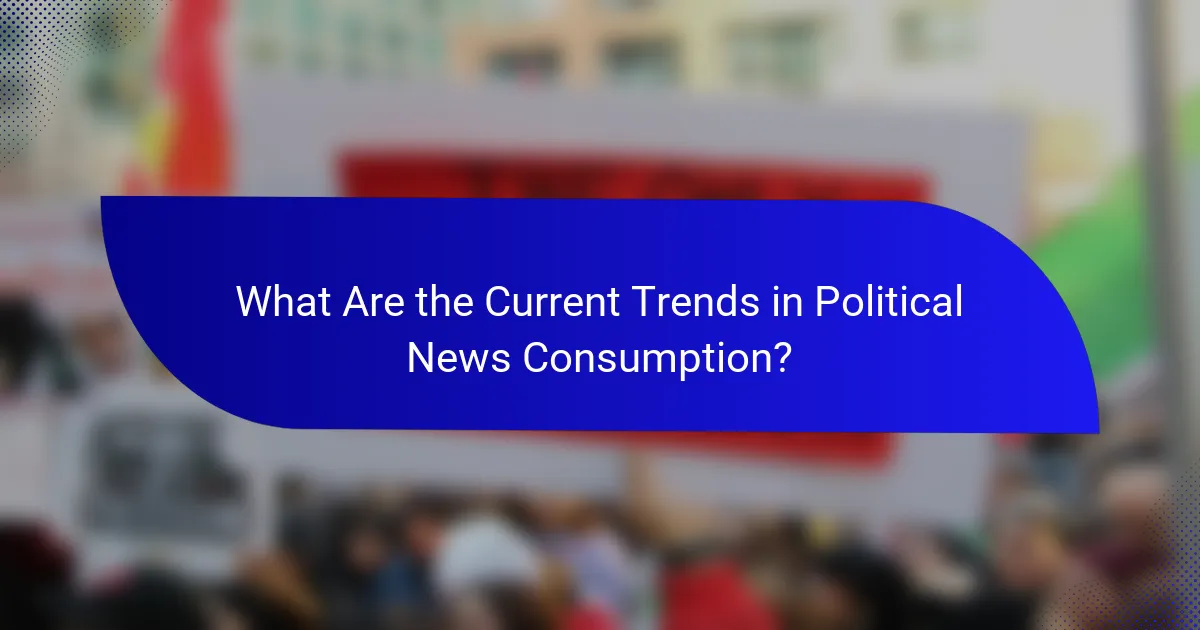
What Are the Current Trends in Political News Consumption?
Current trends in political news consumption indicate a significant shift towards digital platforms, particularly social media. Users increasingly prefer engaging with news through visual content, short articles, and interactive formats that allow for immediate feedback and participation.
Shift towards video content
Video content has become a dominant medium for political news, with platforms like YouTube, TikTok, and Instagram leading the way. These platforms allow for quick dissemination of information, often in a more engaging format than traditional articles. Viewers are drawn to short clips that summarize key political events or provide commentary, making video a powerful tool for news consumption.
As a result, news organizations are investing more in video production, often creating content specifically tailored for social media audiences. This trend reflects a broader preference for dynamic storytelling that captures attention quickly.
Rise of citizen journalism
Citizen journalism has gained traction as individuals use smartphones and social media to report on political events in real time. This grassroots approach allows for diverse perspectives and immediate coverage of breaking news that traditional media may overlook. Social media platforms serve as a primary outlet for these reports, enabling rapid sharing and discussion.
While citizen journalism can enhance the richness of political discourse, it also raises concerns about accuracy and reliability. Consumers should critically evaluate the sources of such information and consider cross-referencing with established news outlets.
Preference for short-form content
There is a growing preference for short-form content in political news, with many users favoring quick reads over lengthy articles. Platforms like Twitter and Snapchat cater to this demand by providing bite-sized updates that deliver essential information swiftly. This trend reflects a broader shift in attention spans, particularly among younger audiences.
News organizations are adapting by creating concise summaries and infographics that highlight key points. This approach allows consumers to stay informed without investing significant time, making it easier to engage with multiple news stories throughout the day.
Increased use of fact-checking tools
As misinformation spreads rapidly on social media, the use of fact-checking tools has become crucial for consumers of political news. Websites and browser extensions that verify claims can help users discern credible information from false narratives. Many news organizations now include fact-checking segments in their reporting to enhance transparency and trust.
To navigate the political news landscape effectively, individuals should utilize these tools regularly and remain skeptical of sensational claims. Engaging with reputable fact-checking sources can significantly improve the quality of information consumed and contribute to informed discussions.
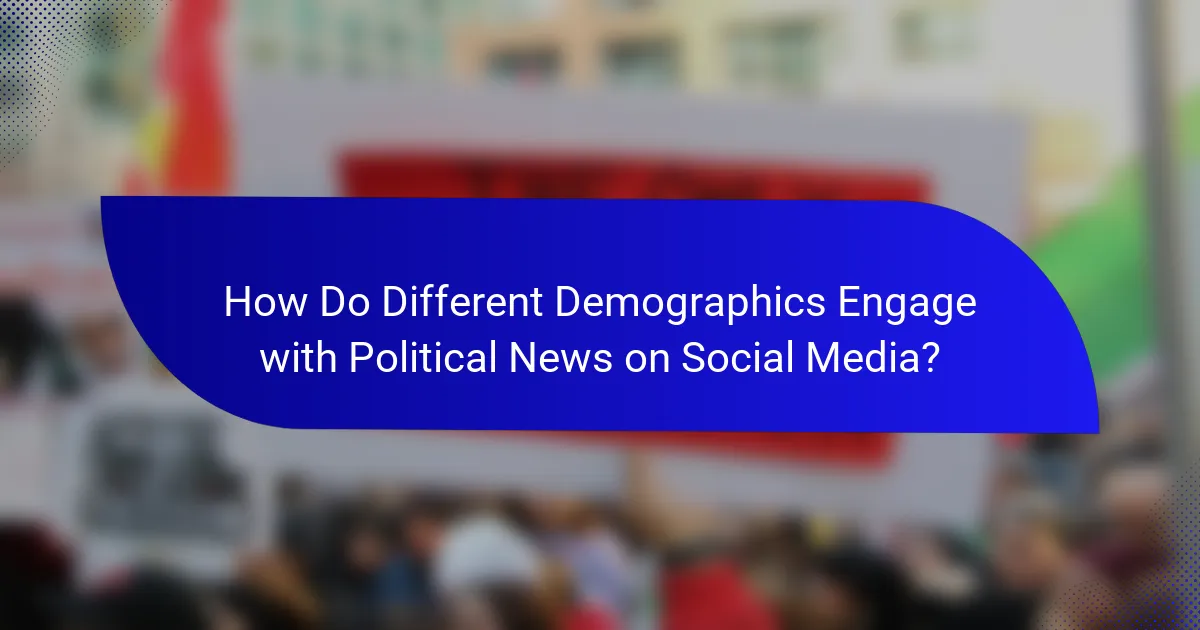
How Do Different Demographics Engage with Political News on Social Media?
Engagement with political news on social media varies significantly across different demographics. Younger users, particularly Millennials and Gen Z, tend to favor platforms like Instagram and TikTok, while older generations often prefer Facebook and Twitter for news consumption.
Millennials and Gen Z preferences
Millennials and Gen Z are more likely to consume political news through visually engaging content on platforms such as Instagram, TikTok, and Snapchat. They prefer short, digestible formats like videos and infographics, which allow for quick understanding of complex issues.
These younger demographics often engage with news content by sharing it within their networks, commenting, and participating in discussions. They value authenticity and are more inclined to trust news from influencers or peers over traditional media sources.
Engagement patterns of older generations
Older generations, including Gen X and Baby Boomers, typically engage with political news through Facebook and Twitter. They often prefer longer articles and in-depth analyses, which they can find on news websites or through shared links on social media.
This demographic tends to engage less frequently with news content but values reliability and established sources. They may share articles with friends and family, contributing to discussions in a more traditional manner compared to younger users.
Regional differences in news consumption
Regional differences significantly influence how demographics engage with political news on social media. For instance, users in urban areas may have higher engagement rates due to better access to high-speed internet and a greater variety of platforms.
In contrast, rural users might rely more on Facebook and local news outlets, reflecting a preference for community-based information. Additionally, cultural factors can shape the types of political content that resonate, with some regions favoring more partisan perspectives while others seek balanced reporting.
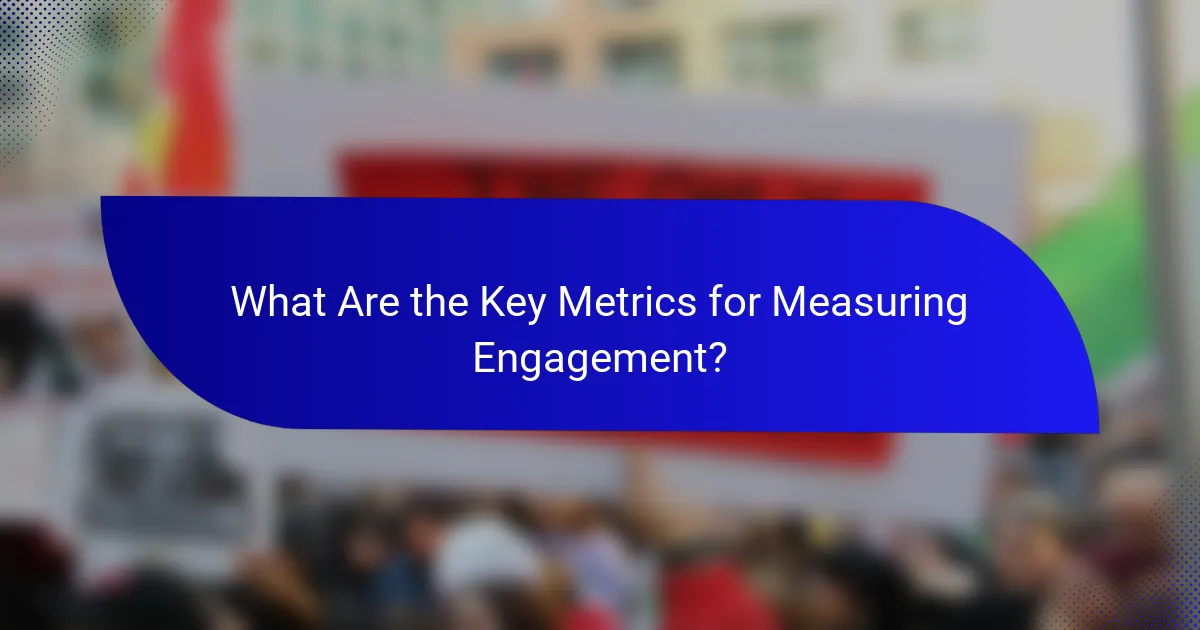
What Are the Key Metrics for Measuring Engagement?
Key metrics for measuring engagement in political news consumption include likes, shares, comments, time spent on content, and click-through rates. These metrics provide insights into how audiences interact with content and can guide strategies for improving reach and impact.
Likes, shares, and comments
Likes, shares, and comments are fundamental indicators of engagement on social media platforms. A high number of likes suggests that content resonates with users, while shares indicate that users find it valuable enough to distribute within their networks. Comments can provide qualitative insights into audience sentiment and encourage further discussion.
When analyzing these metrics, consider the context of the content. For instance, a political article that garners hundreds of likes but few shares may indicate that while it is well-received, it lacks the broader appeal necessary for virality. Aim for a balance where content not only attracts likes but also prompts shares and discussions.
Time spent on content
Time spent on content measures how long users engage with a piece of information before leaving the page. Longer time spent typically indicates that users are finding the content informative or engaging. For political news, this can be particularly telling, as complex topics may require more time for comprehension.
To improve time spent on content, consider using engaging formats such as videos, infographics, or interactive elements. Additionally, breaking up text with subheadings and bullet points can make it easier for users to digest information, potentially increasing their time on the page.
Click-through rates
Click-through rates (CTR) reflect the percentage of users who click on a link compared to the total number of users who view the content. A higher CTR indicates that the content is compelling enough to prompt action, which is crucial for driving traffic to articles or reports. For political news, a strong CTR can signify effective headlines and relevant topics.
To enhance CTR, focus on crafting attention-grabbing headlines and compelling calls to action. Testing different headlines and content formats can help identify what resonates best with your audience. Monitoring CTR over time can also reveal trends that inform future content strategies.
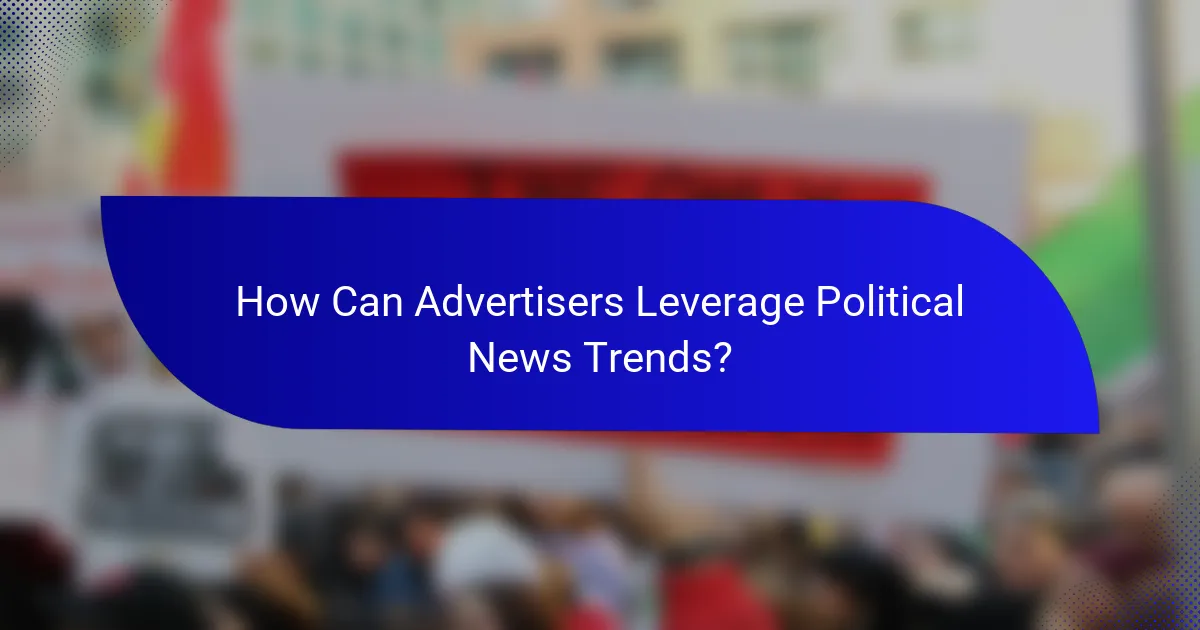
How Can Advertisers Leverage Political News Trends?
Advertisers can effectively leverage political news trends by aligning their messaging with current events and public sentiment. Understanding the dynamics of political engagement on social media allows brands to craft targeted campaigns that resonate with audiences during key moments.
Understanding Audience Sentiment
To leverage political news trends, advertisers must first gauge audience sentiment. This involves analyzing social media conversations and engagement metrics to understand how people feel about specific issues. Tools like sentiment analysis software can help identify positive, negative, or neutral reactions to political topics.
For example, if a political event generates significant positive sentiment, brands can create campaigns that align with that positivity. Conversely, if sentiment is largely negative, advertisers should approach with caution, ensuring their messaging does not appear tone-deaf or opportunistic.
Timing and Relevance
Timing is crucial when leveraging political news trends. Advertisers should monitor news cycles closely and be prepared to act quickly. Campaigns that are timely and relevant to ongoing political discussions are more likely to capture attention and engagement.
For instance, launching a campaign that supports a social cause during a related political event can enhance visibility. However, brands must ensure that their messaging is authentic and not merely a reaction to trends, as this can lead to backlash.
Creative Messaging Strategies
Creative messaging strategies are essential for engaging audiences during politically charged times. Advertisers should consider using humor, storytelling, or emotional appeals that resonate with current political narratives. This approach can help differentiate their brand in a crowded marketplace.
For example, a brand might create a video campaign that highlights community values in response to a political issue, fostering a connection with the audience. It’s important to keep messaging consistent with the brand’s identity while still being responsive to political trends.
Ethical Considerations
Ethical considerations are paramount when engaging with political news trends. Advertisers should avoid exploiting sensitive issues for profit and ensure their campaigns promote constructive dialogue. Transparency and authenticity are key to maintaining trust with consumers.
Brands should also be aware of regulations regarding political advertising, which can vary by region. In the U.S., for example, the Federal Election Commission has specific rules about political ads that must be followed to avoid legal issues.
